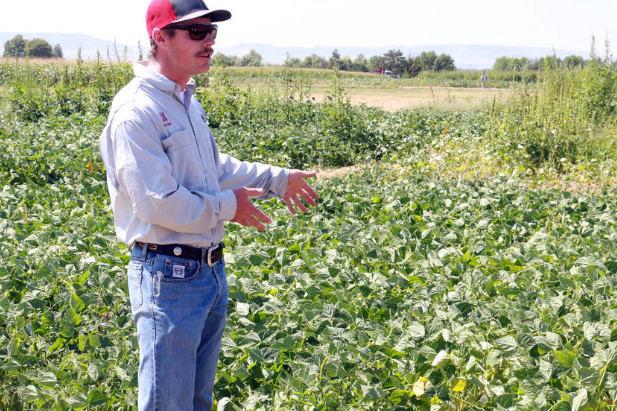SCOTTSBLUFF — Work is being done at the Panhandle Research and Extension Center to find ways to control Palmer ameranth, a relatively new weed to the Panhandle that has proven difficult to manage.
A member of the ameranthus genus, Palmer ameranth is related to redroot pigweed, tumble pigweed, and prostrate pigweed. It originated in the American southwest and northern Mexico and was first identified as a weed when it began infesting cotton fields in the American southeast. Integrated weed management specialist Nevin Lawrence said it’s unclear when, exactly, it began to appear in Nebraska.
“I did my masters project at the Panhandle Research and Extension Center in 2009 and 2010, and at that point, if there was any Palmer ameranth, it was likely just a very isolated population of just a few plants,” he said. “My guess is that it began showing up in the panhandle of Nebraska in the last 10 years, but we don’t have a firm date on that.”
When Lawrence started at PREC in 2016, he had intended to research the management of other weeds. When he went out to the research plots, however, it became clear that Palmer ameranth was a concern.
“I had all these studies put out to look at the management of other weeds,” he said. “Those weeds just never came, just the Palmers, so those quickly turned into Palmer experiments.”
Palmer ameranth is similar to redroot pigweed, “it’s just a lot bigger and nastier,” Lawrence ssaid. “It grows larger, it grows faster, it produces more seeds, it’s more competitive with crops. It’s just like redroot pigweed, but from a farmer’s perspective, it’s worse.”
Almost all of the research Lawrence does on the weed is on how to control the weed, primarily in dry beans and sugar beats with some research on corn and wheat as well. He looks at ways to manage the weed, both through herbicide and through pillage and crop rotation. In sugarbeets and dry beans, he’s applied different mixes of various herbicides to see what works, and has tried unconventional timings to prevent emergence.
Part of the problem with Palmer is that the weed is adapted to the American southwest climate. “It’s very, very drought tolerant,” Lawrence said, “and it’s able to produce seed and grow in very dry conditions.” Yet, at the same time, it’s done very well in the American southeast, where it much more humid, and is being found as far north as North Dakota and Wyoming.
“Generally, weeds that are able to survive diverse conditions tend to be the weeds that are also quickest to become resistant to different herbicides,” Lawrence said. “The biggest trait that Palmer has is that it’s very adaptive to management practices. Regardless of cropping system, regardless of environment, it usually finds a way to survive.”
The other half of the problem with Palmer ameranth is that populations of the weed are resistant to glyphosate, a commonly-used broad spectrum herbicide. Thirty-three percent of the samples Lawrence and his researchers have sent for testing have come back resistant to the herbicide. He added that overexposure is not the cause of the resistance: genetic screening of seed samples dating back to the 19th century, before modern herbicide use, showed that plants were already naturally resistant to glyphosate.
“The more we spray an herbicide,” he said, “we’re not more likely to cause a resistance, we’re more likely to find it.”
So far, Lawrence and his team have not had much success to controlling Palmer ameranth — “We’ve found a lot of things to not do,” he said — but he did have some suggestions. Corn, wheat, and other tall crops are better at suppressing the weed, and are more likely to resist the herbicides that do kill Palmer ameranth that short-statured crops like dry beans and sugarbeets, making crop rotation a viable control strategy.
“You might not think about managing Palmer as much in your corn,” he said, “but that’s your opportunity to get ahead of it.”
Soil-applied herbicides, intended to prevent the weed seeds from germinating, also tend to work better than post-emergence herbicides.
More information about Lawrence’s work can be found during field tours at PREC, the Crop Production Clinic in January, and through the bulletins published at the UNL blog CropWatch.
Credit: www.starherald.com

